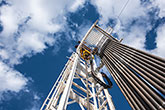Atmospheric water generation
Published by Joseph Green,
Editor
Oilfield Technology,
Like any industry, the oil and gas sector is ripe for innovation as we look for improved and more efficient ways to develop our planet’s energy sources. One such aspect is the increased need for new technologies to provide alternative resources for clean water. While most oil and gas outfits rely on freshwater for the majority of their needs, the Texas Oil and Gas Commission recently reported that non-freshwater has become more popular over the past three years, jumping from 3% to 21%, an increase of over 300%.
This is a trend that points to an opportunity for market penetration, as increased use and demand from oil and gas companies is expected to continue. Consider California, which possesses one of the potentially largest natural gas plays in the Monterey Shale. The cost of mining that shale has been considered too expensive to efficiently fit into the gasoline production business model, and the use of fresh water contributes greatly to that expense.
These problems are shared in multiple regions around the country, where local communities are feeling the strain of oil and gas developers who have descended upon them and tapped in to their water supply. But available technology, such as atmospheric water generation, can reduce the draw on municipal resources in water-starved locations, and provide a cost-effective way for drillers to continue their operations without being a drain on local resources.
What is atmospheric water generation?
Atmospheric water generation extracts the water directly from water vapour that exists in the very air we breathe, transforming humidity into an abundant source of clean water at or near the point of use/distribution. Using a refrigeration-based process, moist air is passed over a cold surface, which condenses the moisture into droplets that are captured, filtered, sterilised, and stored for use.
The air is chilled to the dew point, and the moisture is condensed and filtered to the point of purity that it could be consumed.
Water can be produced using 100 percent outside air, in areas with humidity levels as low as 40 percent. Most systems run on simple electricity, and only need modest maintenance consisting of filter changes and general cleaning, resulting in a simple “plug-and-play” water generator that for the most part operates and maintains itself.
Water is the world’s most abundant resource – 70 percent of the Earth’s surface is covered in it – but it’s not always readily available at locations primed for fracking and drilling. There are water shortage issues in Texas, where hot summers leave farmers and shale-gas developers fighting for whatever water is available, and in Louisiana, where the Carrizo-Wilcox Aquifer has started to run dry.
Fortunately atmospheric water generation can be implemented commercially on a wide scale, and can help to ease the strain that fracking puts on our planet’s natural water sources.
What it means for oil and gas
There are a host of potential applications for atmospheric water generation technology within the oil and gas industry, with the most notable being for fracking. It can take anywhere from three to five million gallons of water to frack a well, so it’s not hard to imagine an issue with many drilling locations located in areas suffering from water scarcity.
Drilling mud also requires moderate use of water, up to 10-15,000 gallons per day, while steam and/or hot water are often used in some types of formations for separation of hydrocarbons from the mineral structure they are bound to. Then there is water injection, used to drive hydrocarbons to higher points in the formation for recovery
In order to complete these operations, water is traditionally piped in from local lakes, ponds, or reserves, or trucked in from even further out of town. This can be incredibly expensive and time consuming, and can deplete water sources that are also relied upon to serve municipalities local to the drilling sites.
There is AWG equipment that can be set up on site early in the well development process, and the water that is accumulated can be stored in tanks or lined pits for later use in the fracking process. They could produce 400 gallons of water per day, with systems in development that could produce up to 20,000 gallons of water per day.
There are 35 000 wells being fracked in the United States each year, impacting local water supplies and exacerbating by the drought conditions that many areas around the country are facing. Utilising this technology can easily supplement and in some cases, even replace the original source of water used to frack a well, preserving local water supplies and resources in a cost effective and sustainable manner.
By Keith White, CEO, Ambient WaterRead the article online at: https://www.oilfieldtechnology.com/exploration/04122014/atmospheric-water-generation-keith-white-ambient-1930/
You might also like
tengizchevroil starts WPMP operations at tengiz oil field in Kazakhstan
Chevron has announced today that its 50 % owned affiliate Tengizchevroil LLP (TCO) has safely commenced operations at its wellhead pressure management project (WPMP) at the Tengiz oil field in Kazakhstan.

